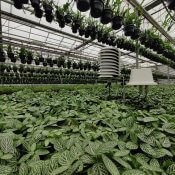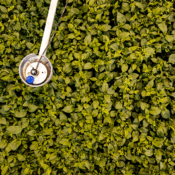Measuring crop-level dew point is not a myth
Ask any grower about his or her experience with dew point and they’ll tell you about the potentially destructive impact, from mildew to Botrytis that moisture can have on crops. But while excessive moisture can potentially destroy a crop, we hear from growers that they aren’t always able to do much to combat its effect.
What’s missing?
To respond meaningfully, farmers need data— and quite a bit of it. Beyond the dew point itself, growers need metrics that provide context on their crops and the conditions surrounding them. Wireless sensor technology can help farmers monitor crop-level dew point, ambient temperature and humidity, vapor pressure deficit, light intensity, soil moisture and more, sending real-time data to an intuitive dashboard, showing alerts on any device. That’s where smart sensing comes in.
Entrepreneurs in the agricultural sector are always on the lookout for new methods to optimize cultivation and maximize yield. We’ve seen first-hand how pepper, strawberry and tomato growers have harnessed real-time data to track and control their crops’ dew point, so it’s crucial for non-farmers like ourselves to understand this important metric.

Measuring dew point has never been easy
When unsaturated air cools, it becomes increasingly saturated. At a certain temperature, the air will become completely saturated with water vapor. This temperature is called the dew point or the dew point temperature. If the air cools past its dew point temperature, condensation will occur. If fruits, stalks or other parts of the plant are colder than the dew point, they become wet because the water vapor condenses on them. Unfortunately, this offers ideal conditions for moisture-borne diseases and fungi.
Dew point needs context
Using a formula that incorporates ambient temperature and relative ambient humidity,
climate computers have been able to determine the dew point within a greenhouse for quite some time. But this measurement itself has been of little use to farmers without the context of crop-level temperature to make it actionable. As farmers tell us, making this comparison has been labor-intensive and risked inconsistency.
Traditionally, crop managers compare dew point temperature generated by a climate computer with manual crop temperature measurements. Manual measurements risk a margin of error in the results, but also fail to account for possible climate discrepancies across greenhouse sections, which cause variations in dew point. This form of measurement can’t guarantee continuous, real-time metrics. Enter the 30MHz Smart Sensing Toolkit.
Measuring dew point with smart sensing technology
With input from various growers, 30MHz has succeeded in making dew point management simpler, less labour-intensive, while improving accuracy and accounting for climate inequality throughout greenhouses. A combination of smart sensors, including the pointed micro climate sensor, the temperature/humidity sensor and the pointed temperature sensor enable farmers to determine the dew point in the immediate vicinity of a plant or fruit and to immediately combine this with the current real-time object temperature of the plant or fruit. All data is easily viewable in the dashboard.
Want to know more about measuring dew point in your greenhouse? Have questions for growers already using smart sensing technology to optimize their crops? Get in touch below.


30MHz is typing… Our extended support team is ready to chat!
At 30MHz we think it’s important that our users can use our platform in an optimal way. At times you may have questions and you would like some help from our support team. Email and our support page filled with helpful articles were your go to’s. But we thought it was time for something extra… ...Read more
New 30MHz connect casing: How we protect your tech
To make sure your dataflow is fully protected, 30MHz introduces a new connect casing: waterproof, dust proof and even resistant to hits. This special shield will last longer and ensure a reliable dataflow from the connected sensor. What does that full protection mean? That’s what we will explain in this article. Watertight: resistant to wetness ...Read more
Most popular sensors for your greenhouse
As a grower, you know that optimal crop development starts with precise monitoring of your cultivation environment. But how do you transform raw data into actionable insights for your crops? This is where our wireless sensors and the 30MHz platform come together. Our sensors measure essential variables such as VPD, dew point, moisture deficit, EC, ...Read more


